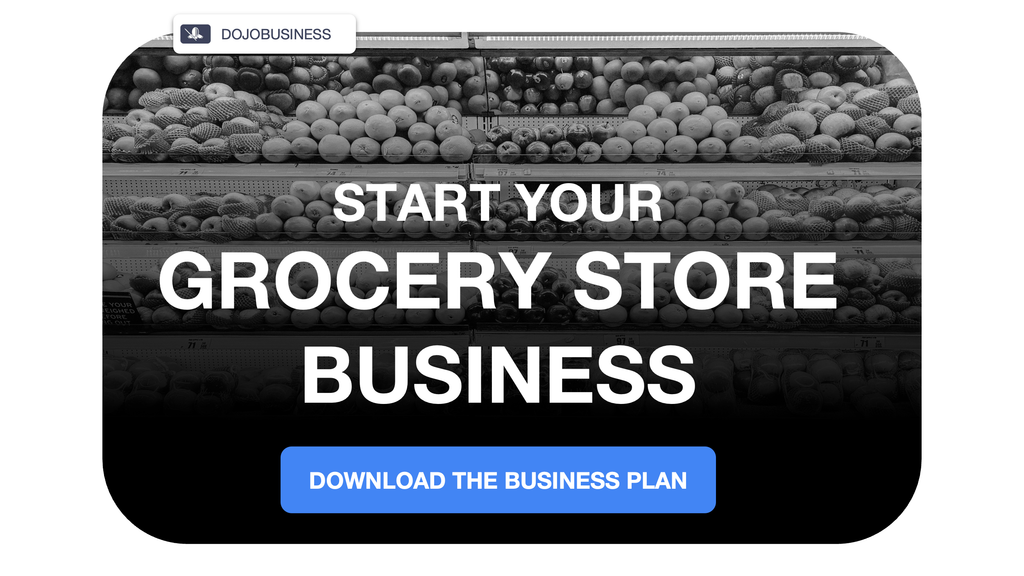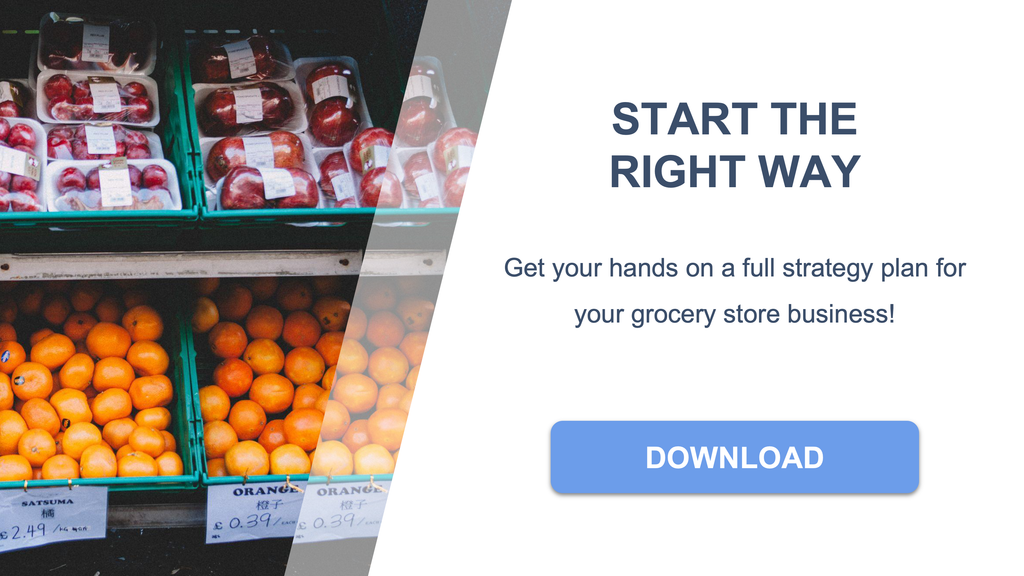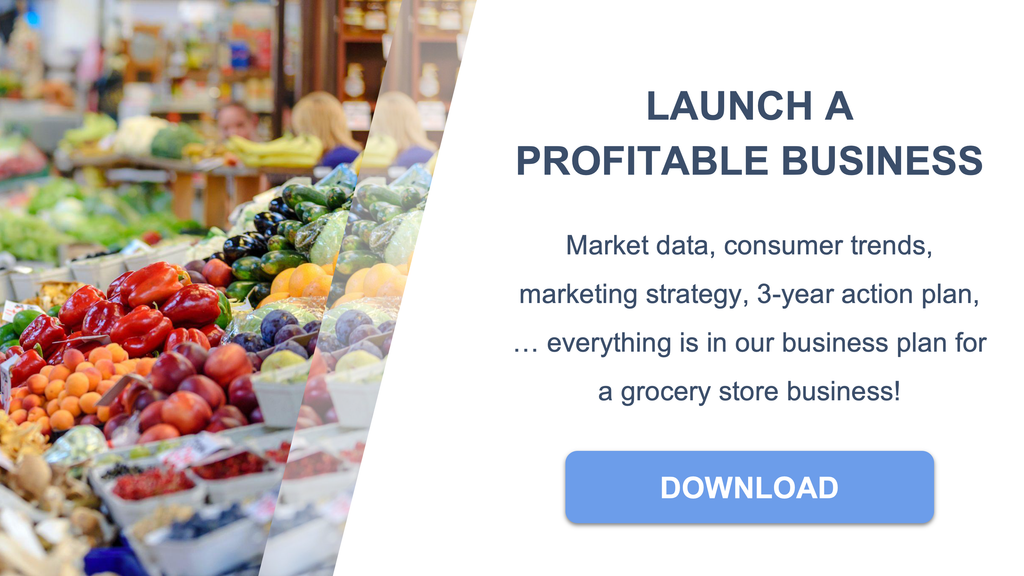This article was written by our expert who is surveying the industry and constantly updating the business plan for a grocery store.

Setting up initial inventory for a grocery store requires precise planning to balance customer demand with cash flow constraints.
The first three months are critical for establishing product mix, stock levels, and replenishment cycles that will define your store's profitability and customer satisfaction. If you want to dig deeper and learn more, you can download our business plan for a grocery store. Also, before launching, get all the profit, revenue, and cost breakdowns you need for complete clarity with our grocery store financial forecast.
Launching a grocery store demands careful inventory planning across all product categories to avoid cash flow problems and stock issues.
The table below provides essential benchmarks for initial inventory setup, including demand estimates, stock levels, margins, and budget requirements for new grocery store owners.
| Category | Initial Stock Level | Sales Percentage | Gross Margin | Key Considerations |
|---|---|---|---|---|
| Fresh Produce | 1–1.5 weeks turnover | 20–25% of sales | 30–40% | Order for 5–7 days only; arrange 2–4 weekly deliveries to minimize spoilage (4–7% expected) |
| Dry Goods | 3–4 weeks turnover | 25–30% of sales | 16–22% | Longest shelf life allows larger initial orders; focus on staple items with proven demand |
| Frozen Foods | 2–3 weeks turnover | 10–15% of sales | 18–24% | Requires freezer capacity planning; lower spoilage risk but higher equipment costs |
| Beverages | 2–3 weeks turnover | 10–13% of sales | 18–24% | Heavy and bulky; plan storage and floor space accordingly for efficient rotation |
| Household Items | 4 weeks turnover | 10–12% of sales | 20–28% | Slower movers but essential for one-stop shopping; private label offers better margins |
| Initial Investment | Varies by store size | N/A | N/A | Small stores: $20,000–$35,000; Medium: $30,000–$75,000; Large: $100,000+ |
| Branded vs. Private Label | 60–70% branded at launch | N/A | 25–35% for private label | Start with trusted brands for customer confidence; add private label for competitive pricing |

How much customer demand should I expect for each product category in the first three months?
Customer demand in the first three months varies significantly based on your grocery store's location, size, demographics, and nearby competition.
Most small to mid-sized grocery stores experience monthly sales distributed as follows: fresh produce accounts for 20–25%, dry goods represent 25–30%, frozen foods take 10–15%, beverages make up 10–13%, and household items contribute 10–12%. These percentages provide a baseline for forecasting initial demand across categories.
Your actual demand will depend on local population density and shopping patterns. A store in a residential neighborhood with young families will see higher demand for fresh produce and dairy, while a location near offices may experience greater beverage and ready-to-eat food sales. Analyze the performance of nearby competing stores and conduct demographic research to refine these estimates for your specific market.
Calculate your projected weekly foot traffic based on the local population within a 1-mile radius, then multiply by average basket size to estimate total sales. Break down this total by the percentages above to determine category-specific demand. Expect demand to build gradually over the first 12 weeks as customers discover your store and establish shopping routines.
What initial stock levels should I maintain for each product category?
Initial stock levels for a grocery store must balance the need to present a full shelf appearance with the risk of tying up cash in slow-moving inventory.
For fresh produce, stock 1–1.5 weeks of anticipated turnover per item to minimize spoilage while ensuring variety and freshness. Dry goods require 3–4 weeks of turnover per SKU since these items have extended shelf life and form the backbone of your store's offerings. Frozen foods should maintain 2–3 weeks of turnover per SKU, balancing storage capacity with customer selection.
Beverages also need 2–3 weeks of turnover per SKU, though popular items like bottled water and soft drinks may require higher levels due to their bulk and fast movement. Household items typically stock for 4 weeks of turnover as these are slower-moving products that customers expect to find consistently available.
To calculate specific unit quantities, estimate your weekly sales per item based on target foot traffic and historical industry averages for stores of your size. Multiply these weekly sales figures by the recommended stock duration for each category. For a new grocery store, start conservatively and adjust based on actual sales data from your first few weeks of operation.
You'll find detailed market insights in our grocery store business plan, updated every quarter.
How fast do different grocery items sell in a new store?
| Product Type | Annual Inventory Turns | Typical Sell-Through Rate | Examples and Notes |
|---|---|---|---|
| Fast-Moving Items | 7–15 turns per year | Weekly to bi-weekly complete sell-through | Bread, milk, eggs, bananas, top-selling snacks, bottled water. These drive foot traffic and require frequent restocking. |
| Medium-Moving Items | 6–8 turns per year | Bi-weekly to monthly turnover | Canned goods, pasta, rice, cereals, frozen vegetables. Steady demand but not daily purchases for most customers. |
| Slow-Moving Items | 2–6 turns per year | Monthly to quarterly turnover | Specialty sauces, ethnic foods, seasonal items, niche cleaning products. Important for variety but require careful ordering. |
| Very Slow Movers | 1–2 turns per year | Quarterly to semi-annual turnover | Holiday-specific items, specialty baking ingredients, premium imported goods. Order minimally until demand is proven. |
| Promotional Items | Varies (10–20 turns when on promotion) | Can sell out within days during promotion | Loss leaders and advertised specials. Stock heavily during promotional periods, return to normal levels after. |
| Private Label Products | 4–10 turns per year | Weekly to monthly depending on category | Store brand items typically turn slower than national brands initially but build loyalty over time with better margins. |
| Perishables (Dairy/Meat) | 15–30 turns per year | 2–3 times weekly restocking needed | High velocity but short shelf life. Requires tight inventory management and frequent deliveries to minimize waste. |
What are the shelf life standards for perishable products?
Understanding shelf life for perishable products is essential for determining opening order quantities and establishing reorder schedules in your grocery store.
Dairy products typically last 7–14 days from delivery, with milk at the shorter end (7–10 days) and hard cheeses extending to 14 days or more. Bread and bakery items have the shortest shelf life at 2–5 days, requiring daily or every-other-day deliveries for optimal freshness. Fresh meat products remain saleable for 3–7 days depending on packaging and type, with ground meat at the lower end and whole cuts lasting longer.
Fresh produce varies widely by item, ranging from 3–10 days. Leafy greens and berries spoil quickly (3–5 days), while root vegetables and apples can last 7–10 days or longer under proper refrigeration. Prepared foods and deli items typically have a 2–4 day shelf life and require careful daily monitoring.
For your opening orders, calculate quantities to cover 5–7 days of sales for most perishables, never more. Arrange delivery schedules with suppliers for 2–4 times per week replenishment to maintain freshness and minimize spoilage. This frequent delivery approach reduces waste significantly compared to weekly ordering, even though it requires more administrative effort.
What shrinkage and spoilage rates should I plan for in the first quarter?
Shrinkage and spoilage represent unavoidable losses in grocery store operations that must be factored into initial inventory planning and pricing strategies.
Industry benchmarks for the first quarter indicate shrinkage (theft, damage, administrative errors) typically ranges from 1.5–2.5% of total sales. Spoilage for perishable products runs higher at 4–7% of inventory value, with fresh produce and meat experiencing the highest loss rates. New grocery stores often experience rates at the higher end of these ranges due to learning curves in ordering, handling, and merchandising.
Factor these percentages into your initial orders by building in a buffer for perishables—order slightly above your calculated demand to account for expected losses. For example, if you project selling 100 units of fresh produce weekly, order 105–107 units to account for the 4–7% spoilage rate. Monitor and track all waste daily by category to identify problem areas and adjust ordering patterns.
Implement strict inventory control procedures from day one, including first-in-first-out (FIFO) rotation, regular temperature monitoring for refrigerated items, and daily freshness checks. Train staff thoroughly on proper handling procedures and establish clear processes for marking down near-expiration items before they become total losses. Your shrinkage and spoilage rates should decrease to 1–1.5% and 2–4% respectively within six months as you refine operations.
What minimum order quantities and lead times do suppliers require?
Understanding supplier requirements for minimum order quantities (MOQs) and lead times helps you plan cash flow and avoid stockouts during your grocery store's launch period.
Major wholesalers and distributors typically require minimum order quantities of one case per SKU, though case sizes vary dramatically by product—a case might contain 12 units of cereal or 48 units of canned soup. Some suppliers impose minimum order values (often $150–$500) rather than per-item MOQs, allowing you to mix products to meet the threshold. National distributors may offer more flexibility for new stores, including split-case ordering at a slight premium.
Lead times vary by supplier proximity and product type. Local and regional distributors generally deliver within 2–7 days of order placement, while national suppliers require 7–14 days. Fresh produce and dairy typically operate on shorter cycles with next-day or 2-day delivery due to perishability. Specialty items, imported goods, and seasonal products may require 14–21 days or longer.
Negotiate with your primary suppliers during the onboarding process to understand their specific requirements and flexibility. Many suppliers waive or reduce MOQs for grand opening orders or establish special terms for the first 60–90 days to help new grocery stores build inventory. Establish relationships with multiple suppliers per category to ensure backup options if your primary source faces delays or stockouts.
This is one of the strategies explained in our grocery store business plan.
What should my branded-to-private-label product ratio be at launch?
The ratio of branded products to private-label or generic items at your grocery store launch directly impacts customer perception, margins, and competitive positioning.
Industry standards suggest starting with 60–70% branded national products and 30–40% private label or generic items. Leading with trusted national brands builds immediate customer confidence and attracts shoppers familiar with these products from other stores. Well-known brands serve as anchors that draw foot traffic and establish your store's credibility during the critical opening months.
Integrate private label and generic items strategically to offer competitive pricing and improve profit margins, which typically run 25–35% for store brands compared to 16–24% for national brands in categories like dry goods and household items. Focus your private label selection on staple items where customers show less brand loyalty—paper products, basic canned goods, pasta, rice, and cleaning supplies perform well as store brands.
Gradually increase your private label percentage to 35–45% over the first year as you build customer trust and loyalty. Position private label products directly next to their branded equivalents on shelves to facilitate price comparison and trial. Ensure your private label items meet quality standards—poor quality store brands damage overall store perception more than the margin benefit justifies.
How should I allocate floor space and inventory across product categories?
| Product Category | Floor Space % | Inventory % | Allocation Rationale and Considerations |
|---|---|---|---|
| Fresh Produce | 15–20% | 15–20% | Prime location near entrance for visual appeal and freshness perception. Requires refrigerated display cases, misting systems, and frequent restocking. High shrinkage risk demands careful inventory management. |
| Dry Goods / Pantry | 35–40% | 35–40% | Largest category providing core staples customers expect. Central aisle placement with organized sections by type (canned goods, pasta, baking, snacks). Highest variety of SKUs requiring extensive shelving. |
| Frozen Foods | 10–12% | 10–12% | Requires significant upfront investment in freezer cases and ongoing energy costs. Position along perimeter for easy access. Include frozen vegetables, meals, ice cream, and frozen meat/seafood sections. |
| Beverages | 10% | 10–12% | Heavy products requiring floor-level or low-shelf placement for safety and customer convenience. Dedicate end caps to promotional items. Include both refrigerated and shelf-stable sections. |
| Household Items | 10–12% | 10–12% | Cleaning supplies, paper products, health and beauty aids, and pet supplies. Often placed in rear of store to drive customer traffic through other departments. Lower velocity but essential for one-stop shopping. |
| Dairy and Refrigerated | 8–10% | 8–10% | Perimeter wall placement with open refrigerated cases. High-traffic department requiring daily attention. Includes milk, eggs, cheese, yogurt, and refrigerated prepared foods. Plan for backup refrigeration systems. |
| Meat and Seafood | 5–8% | 5–7% | Requires specialized refrigeration, preparation area, and trained staff. Position near produce for meal planning convenience. Higher margins offset lower space allocation. Consider starting with prepackaged items only. |
What gross margins should I expect by product category?
Gross margins by product category vary significantly in grocery stores and directly influence your purchasing decisions and overall profitability.
Fresh produce delivers the highest margins at 30–40%, though this comes with increased spoilage risk and handling requirements. Dry goods generate lower margins of 16–22% but compensate through volume and minimal waste. Frozen foods and beverages both produce margins in the 18–24% range, offering a middle ground between profitability and turnover.
Household items provide margins of 20–28%, with higher-end health and beauty products at the upper range and basic cleaning supplies at the lower end. Private label products across all categories typically deliver 25–35% margins, significantly higher than their branded equivalents. Meat and seafood can achieve 25–35% margins when you have an in-store butcher or seafood counter, but prepackaged meats run closer to 18–25%.
Use these margin benchmarks to guide your initial purchasing decisions and product mix. Balance high-margin categories like produce and private label with necessary lower-margin staples that drive traffic. Your overall store margin should target 22–28% after accounting for shrinkage and spoilage. Calculate margins on both cost and retail price to understand true profitability, and adjust pricing strategically to remain competitive while protecting margins.
What inventory management systems work best for new grocery stores?
Selecting the right inventory management system from day one enables accurate tracking, timely reordering, and data-driven decisions in your grocery store.
Square for Retail offers an affordable, user-friendly solution for small to medium grocery stores, with real-time inventory tracking, integrated payment processing, and basic reporting capabilities. Lightspeed Retail provides more advanced features including supplier management, purchase order automation, and detailed analytics, making it suitable for stores planning growth. QuickBooks POS integrates seamlessly with QuickBooks accounting software, simplifying financial management alongside inventory control.
NetSuite ERP represents the enterprise-level option for larger grocery stores, offering comprehensive inventory management, warehouse management, and supply chain integration capabilities. Each system provides automatic reorder alerts when stock levels fall below preset thresholds, real-time inventory tracking across multiple locations if needed, and integration capabilities with supplier systems for automated ordering.
Choose a system that scales with your business and integrates with your existing tools—accounting software, supplier portals, and any e-commerce platform if you plan online ordering. Ensure the system can handle grocery-specific requirements like perishable tracking, batch and lot number management, and variable pricing by weight. Implement barcode scanning from day one to ensure accurate inventory counts and faster checkout. Budget $1,500–$5,000 for initial software setup and hardware, with ongoing monthly fees of $50–$300 depending on the system and store size.
We cover this exact topic in the grocery store business plan.
What initial inventory investment should I budget by store size?
Initial inventory investment for a grocery store varies dramatically based on store size, product mix, and target market positioning.
Small grocery stores under 1,500 square feet typically require $20,000–$35,000 for initial stock, covering essential categories with limited variety in each. Medium-sized stores ranging from 1,500–3,000 square feet need $30,000–$75,000 to provide adequate selection across all major categories and establish a competitive presence. Large grocery stores exceeding 3,000 square feet require $100,000 or more to fully stock shelves with comprehensive variety and depth.
These figures represent the inventory investment only and do not include equipment, fixtures, or operating capital. Expect 70–80% of your total startup budget to be tied up in inventory during the first few weeks, creating tight cash flow conditions. Plan for 2–3 week replenishment cycles, meaning you'll need additional working capital to pay for the second inventory order before revenue from the first inventory has fully materialized.
The initial inventory investment must account for the full shelf appearance that customers expect—empty or sparse shelves damage your store's reputation from day one. However, avoid overstocking slow-moving items or ordering excessive variety in untested categories. Start with focused selection in each category, then expand based on actual customer demand patterns observed in your first 60–90 days of operation. Reserve 15–20% of your inventory budget for adjustments and fill-in orders during the first quarter.
What supplier discounts should I expect for opening orders?
New grocery stores can typically negotiate promotional and introductory discounts from suppliers that significantly reduce upfront inventory costs.
- Opening order discounts of 5–15% off wholesale prices are standard from most major distributors who want to establish a relationship with new stores and ensure you stock their products prominently.
- Free marketing support and point-of-sale displays come from many brand manufacturers eager to secure shelf space in a new store, including promotional signage, end-cap displays, and branded fixtures.
- Extended payment terms of 30–45 days instead of the standard 15–30 days provide crucial cash flow relief during your opening period when revenue is building but expenses are high.
- Free delivery on opening orders from local and regional suppliers who waive minimum order requirements or delivery fees to win your business.
- Promotional allowances and co-op advertising funds that offset your grand opening marketing costs when you feature specific products in your advertising.
- Exclusive new store programs from some manufacturers that provide additional discounts, free samples for customers, and dedicated sales support during your first 90 days.
- Volume commitment discounts where suppliers offer better pricing if you commit to specific purchase volumes over your first six months, though negotiate carefully to avoid overcommitting before you understand demand.
Conclusion
This article is for informational purposes only and should not be considered financial advice. Readers are encouraged to consult with a qualified professional before making any investment decisions. We accept no liability for any actions taken based on the information provided.
Proper inventory management forms the foundation of grocery store profitability and customer satisfaction.
The benchmarks and strategies outlined above provide a framework for your initial inventory setup, but remain flexible and responsive to your actual sales data during the opening months. Continuous monitoring, supplier relationship building, and data-driven adjustments will optimize your inventory investment and position your grocery store for sustainable success.
Sources
- Food Industry - Grocery Store Inventory Management
- NACS - State of the Industry Report
- Food Marketing Institute - Research Reports
- Supermarket News - Shrinkage Benchmarks
- Retail Dive - Grocery Margins Analysis
- Progressive Grocer - Wholesale Distributor Directory
- Shopify - Inventory Management for Grocery Stores
- Square - How to Stock a Grocery Store
-How Much Does It Cost to Buy a Grocery Store
-Understanding Grocery Store Profit Margins
-How Much Does It Cost to Build a Grocery Store
-Complete Grocery Store Business Plan Guide
-Grocery Store Income Per Month Breakdown
-The Complete Guide to Opening a Grocery Store
-Grocery Profit Margin Analysis
-Calculating Your Grocery Store Break-Even Point
-Grocery Store Equipment Budget Planning






